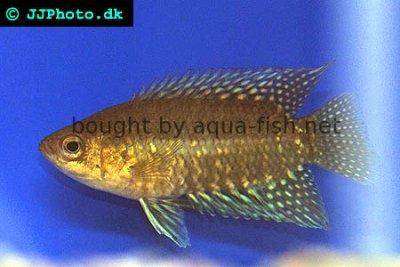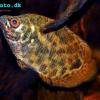Congo ctenopoma - Microctenopoma congicum
Scientific name: Microctenopoma congicum
Common name: Congo ctenopoma
Family: Anabantidae
Usual size in fish tanks: 8 - 9 cm (3.15 - 3.54 inch)
014
Recommended pH range: 6.7 - 7.7
Recommended water hardness: 4 - 22°N (71.43 - 392.86ppm)
0°C 32°F30°C 86°F
Recommended temperature range: 23 - 27 °C (73.4 - 80.6°F)
The way how these fish reproduce: Spawning
Where the species comes from: Africa
Temperament to its own species: peaceful
Temperament toward other fish species: peaceful
Usual place in the tank: Top levels
Origin
The Congo Ctenopoma (Microctenopoma congicum) originates from Africa, specifically found in the dense, slow-moving waters of the Congo River Basin. This environment is rich in submerged vegetation and leaf litter, providing the fish with ample hiding spots and a variety of small invertebrates to feed on. In the wild, they are often seen lurking among plants, waiting to ambush prey.
Short Description
Microctenopoma congicum is a relatively new addition to the aquarium hobby and is prized for its peaceful temperament and striking appearance. They exhibit a muted brown or olive-green coloration, which can change based on mood or breeding season. These fish have an elongated body with a series of vertical stripes along their sides. Like other members of the Anabantidae family, they possess a labyrinth organ that allows them to breathe air at the water's surface. In aquariums, they typically reach a size of 8-9 cm (3.15-3.54 inches). Congo Ctenopoma spend most of their time in the middle to upper levels of the tank but will occasionally explore the substrate for food. With a lifespan of 8-10 years, they can be a long-term and fascinating addition to a well-planted aquarium.
General Care
Congo Ctenopoma thrive in aquariums that replicate their natural habitat. A tank of at least 30 gallons (~113 liters) is recommended for a single specimen, with larger tanks for small groups. The ideal water temperature ranges from 23-27°C (73.4-80.6°F), with a pH level between 6.7-7.7 and water hardness of 4-22°N (71.43-392.86 ppm). Use a soft substrate and provide plenty of hiding spots with live plants such as Java fern, Anubias, and floating plants for cover. Ensure a gentle water flow to mimic their natural environment. When introducing them to a new tank, use a drip acclimation method to prevent shock. Regular water changes are vital for maintaining water quality, but avoid drastic changes that may stress these sensitive fish.
Food and Feeding
Congo Ctenopoma are carnivorous and prefer live or frozen foods such as tubifex, bloodworms, and brine shrimp. They may ignore commercial flakes or pellets when first introduced but can adapt over time. Gradually introduce high-quality flakes and pellets to ensure a balanced diet. Providing a variety of foods, including occasional treats like mosquito larvae, helps maintain their health and encourages natural hunting behavior. Offer live or frozen foods multiple times a week and remove uneaten food promptly to maintain water quality.
Sexing
Male Congo Ctenopoma are distinguishable by their extended dorsal and anal fins, which are more pronounced compared to females. During the breeding season, males may display brighter coloration and increased territorial behavior.
Breeding
Breeding Congo Ctenopoma in captivity is challenging but possible. In the wild, they are bubble nest builders, with the male taking on the parental duties. To encourage breeding in a home aquarium, set up a separate breeding tank with floating plants to support the nest. Slightly increase the water temperature to mimic their natural spawning season. The male will create a bubble nest at the water's surface, where the female will deposit eggs. It is important to replicate their natural environment, including warm, slightly acidic water conditions. Lowering the water level in the breeding tank can further encourage nest building.
Lifespan
With proper care and stable water conditions, Congo Ctenopoma can live for 8-10 years, making them a rewarding long-term addition to a peaceful community tank setup.
Additional Notes
Congo Ctenopoma are best suited for peaceful community tanks. Suitable tank mates include small tetras, rasboras, and peaceful gouramis. They prefer to inhabit the middle to upper levels of the aquarium, so ensure tank mates share a calm temperament. During the breeding season, males may become more territorial. Providing a well-planted tank with dim lighting will help them feel secure and promote natural behaviors. Maintain stable water parameters, monitor for ammonia, nitrites, and nitrates, and conduct regular cleaning to ensure their well-being.
Pictures
Bought by aqua-fish.net from jjphoto.dk.



 Climbing
Climbing  Spotted
Spotted